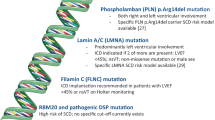Abstract
In adults with structurally normal hearts, the early repolarization pattern (ERP) on electrocardiogram (ECG) may be associated with an increased risk of sudden cardiac death. The prevalence and significance of the ERP in children is unknown. This study examines the prevalence of the ERP, the population in which it is found, and whether there exists any correlation with increased LV mass or family history of significant cardiac events. This was a secondary review of data obtained from healthy adolescents undergoing a limited ECG and transthoracic echocardiogram (TTE) as part of a cardiac screening study. Subjects were excluded if ECG revealed known arrhythmic syndromes or TTE revealed structural abnormalities. ERP was defined as (1) notching or slurring of the terminal QRS; (2) elevation of the QRS-ST junction ≥1 mV; and (3) upwardly concave positive T-wave. Left ventricular (LV) mass was defined as mass/height2.7. Patient demographics, LV mass, family history of sudden death, arrhythmia, and/or ICD/pacemaker placement were compared for subjects with and without ERP on ECG. Data from 575 subjects (median age 15, range 13–18; 36% female; 93% Caucasian) were reviewed. The incidence of ERP was 40% (n = 228) and was seen in the inferior, lateral, or combination of these leads in 42, 10, and 48% of subjects with ERP, respectively. There was no difference in gender (p = 0.7), race (p = 0.7), age (p = 0.3), history of syncope (p = 0.2), LV mass (p = 0.8), family history of (a) sudden death (p = 0.5), (b) arrhythmia (p = 0.2), or (c) ICD/pacemaker requirement (p = 0.8) in subjects with ERP versus those without. However, a greater percentage of patients with ERP were noted to play football, when compared to those without ERP (34 vs. 13%, p < 0.001). ERP is common in healthy adolescents, and does not correlate with concerning personal/family history or elevated LV mass. Longitudinal studies are required to determine whether ERP in childhood confers an increased mortality risk.




Similar content being viewed by others
References
Haissaguerre M, Derval N, Sacher F, Jesel L, Deisenhofer (2008) Sudden cardiac arrest associated with early repolarization. N Eng J Med 358:2016–2023
Obeyesekere MN, Klein GJ, Nattel S, Leong-Sit P, Gula LJ et al (2013) A clinical approach to early repolarizaiton. Circulation 127:1620–1629
Tikkanen JT, Anttonen O, Junttila MJ, Aro AL, Kerola T et al (2009) Long-term outcome associated with early repolarization on electrocardiography. N Engl J Med 361:2529–2537
Noseworthy PA, Weiner R, Kim J, Keelara V, Francis wang et al (2011) Early repolarizaiton in competitive athletes: clinical correlates and the effects of exercise training. Circ Arrhythm Electrophysiol 4:432–440
Antzelevitch C. Genetic (2012) Molecular and cellular mechanisms underlying the J wave syndromes. Circ J 76(5):1054–1065
Crouse SF, Meade T, Hansen BE, Green JS, Martin SE (2009) Electrocardiograms of collegiate football athletes. Clin Cardiol 32:37–42
Rosso R, Kogan E, Belhassen B, Rozovski U, Scheinman MM, Zeltser D, Halkin A, Steinvil A, Heller K, Glikson M, Katz A, Viskin S (2008) J-point elevation in survivors of primary ventricular fibrillation and matched control subjects: incidence and clinical significance. J Am Coll Cardiol 52:1231–1238
Talib AK, Sato N, Kawabata N, Sugiyama E, Sakamoto N et al., Repolarization characteristics in early repolarization and brugada syndromes: insight into an overlapping mechanism of lethal arrhythmias. J Cardiovasc Electrophysiol 25: 1376–1384. doi:10.1111/jce.12566
McIntyre WF, Perez-Riera AR, Femenia F, Baranchuk A (2012) Coexisting early repolarization pattern and brugada syndrome: recognition of potentially overlapping entities. J Electrocardiol 45(3):195–198
Gussak I, Antzelevitch C (2000) Early repolarization syndrome: clinical characteristics and possible cellular and ionic mechanisms. J Electrocardiol 33(4):299–309
Anderson JB, Grenier M, Edwards NM, Madsen NL, Czosek RJ et al (2014) Usefulness of combined history, physical examination, electrocardiogram, and limited echocardiogram in screening adolescent athletes for risk for sudden cardiac death. Am J Cardiol 114(11):1763–1767
Miyazaki S, Shah AJ, Haissaguerre M (2010) Early repolarization: a new electrical disorder associated with sudden cardiac death. Circ J 74:2039–2044
Dekkers C, Treiber FA, Kapuku G, Van Den Oord EJ, Snieder H (2002) Growth of left ventricular mass in African American and European American Youth. Hypertension 39(5):943–951
Maron BJ, Doerer JJ, Haas TS, Tierney DM, Mueller FO (2009) Sudden deaths in young competitive athletes: analysis of 1866 deaths in the United States, 1980–2006. Circulation 119(8):1085–1092
Maron BJ, Haas TS, Doerer TS, Thompson PD, Jodges JS (2009) Comparison of U.S. and Italian experiences with sudden cardiac deaths in young competitive athletes and implications for preparticipation screening strategies. Am J Cardiol 104(2):276–280
Author information
Authors and Affiliations
Corresponding author
Ethics declarations
Conflict of interest
There are no relevant conflicts of interest for any author.
Ethical Approval
All procedures performed in studies involving human participants were in accordance with the ethical standards of the institutional and/or national research committee and with the 1964 Helsinki declaration and its later amendments or comparable ethical standards.
Informed Consent
Informed consent was obtained from all individual participants included in the study.
Rights and permissions
About this article
Cite this article
Ahmed, H., Czosek, R.J., Spar, D.S. et al. Early Repolarization in Normal Adolescents is Common. Pediatr Cardiol 38, 864–872 (2017). https://doi.org/10.1007/s00246-017-1594-9
Received:
Accepted:
Published:
Issue Date:
DOI: https://doi.org/10.1007/s00246-017-1594-9




